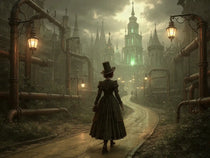To discover Charles Dickens’ “Oliver Twist” is to immerse yourself in one of the most iconic stories in 19th-century English literature. This work explores themes of poverty, social injustice, and redemption through the poignant story of a young orphan. In this article, we’ll cover the key aspects of the novel and why it continues to be a must-read.
Historical Context in this Victorian Era
"Oliver Twist" is a masterpiece by Charles Dickens published in 1837. The story is set in Victorian England, a period marked by deep social inequality and strict poverty laws. The Victorian era was not only a time of wealth and industrial progress; it was also an era when the underprivileged sections of society, especially orphaned children like Oliver, were subjected to inhumane treatment.
The dark mood of this novel is a direct reflection of the setting in which it is set. Victorian England was a time when the Poor Laws and conditions in workhouses and orphanages were often brutal. The board of trustees of these institutions, represented by the character of Mr. Bumble in the novel, were more interested in maintaining order and cutting costs than in the well-being of the residents.
Poor Law
In this context, the Poor Law was a key element that dictated the lives of the destitute. It regulated the fate of people like Oliver's mother and influenced the living conditions in orphanages, making the existence of Oliver and his companions unbearable.
Orphanages and Hospices
The orphanages and almshouses in the book are not just a figment of Dickens' imagination. The deplorable conditions were a sad reality, where hunger and mistreatment were commonplace. The character of Mr Bumble embodies the cruel and insensitive administrative authority.
The City of London
The city of London itself is a character in Oliver Twist, reflecting the darkness and misery that surrounds the young boy. The London underworld, depicted in the novel, highlights the hardships and deprivations experienced by those on the margins of society.
Main characters
Oliver Twist is the innocent and courageous protagonist around whom gravitates a gallery of memorable characters. From the infamous Fagin to the delicate Nancy, each character contributes to the unique atmosphere of the novel.
The themes
"Oliver Twist" is much more than just an adventure story. The novel is a profound exploration of the themes of poverty, crime, and institutional corruption that were pervasive in Victorian England. Through the character of the young boy Oliver, Dickens portrays innocence confronted by a ruthless society, raising crucial questions about humankind and social structures.
Poverty and Misery
One of the most obvious themes in the book is poverty. Oliver was born in an orphanage and grew up without family or support. His journey depicts the brutal realities of poverty, including hunger, deprivation, and abuse of the most vulnerable. The harsh living conditions in poorhouses and orphanages are depicted without filter, exposing the flaws in a system that is supposed to help the poor.
Crime and Corruption
The criminal underworld is also a central element of the novel. Characters such as Fagin and Bill Sikes represent the authority figures in the London underworld, where crime is often the only option available for survival. This corruption is not limited to criminals; it extends to institutions and people in positions of authority, as exemplified by the character of Mr Bumble.
Abused Innocence
Oliver serves as a symbol of abused innocence. His purity and naivety are constantly tested by the harsh and often cruel realities of the world around him. This theme invites the reader to reflect on how society treats its most vulnerable members and highlights the inherent flaws of a system that allows such injustices.
Institutional Corruption
The novel also addresses the theme of institutional corruption, particularly through the characters of the orphanage administration such as Mr Bumble. It highlights the misuse of power and the abuse of authority, which contribute to perpetuating the cycle of poverty and misery.
The Figure of Mr. Bumble and the Poor Law in "Oliver Twist"
Mr Bumble is an iconic character in the novel "Oliver Twist" written by Charles Dickens. As an undertaker and representative of the orphanage where Oliver spent his youth, Mr Bumble embodies the darker aspects of the Poor Law of Victorian England. This law, which was supposed to help the destitute, is often criticized for having instead exacerbated their misery.
In the London underworld, life for a young boy like Oliver is far from easy. The character of Mr Bumble in particular treats Oliver and other orphans with a severity that highlights the widespread mistreatment of children in these institutions. The fact that he is responsible for these children, yet so indifferent to their welfare, makes him a perfect illustration of the flaws in the system.
The undertaker's office where Oliver is placed later in the novel represents another aspect of the harsh life in Victorian England. Here too, the young boy is subjected to various forms of deprivation and mistreatment. Oliver's companions, especially those involved in the gang of thieves led by Fagin, are also victims of the same law and system that have trapped Oliver.
Several adaptations of the novel have been made, notably by Roman Polanski, highlighting these themes. Characters such as Mr Brownlow and the Artful Dodger add complexity to this already dark picture of 19th century England.
In short, Charles Dickens' "Oliver Twist" is more than just a soap opera or an adventure film. It is a scathing critique of English society at the time, poignantly illustrated by memorable characters like Mr. Bumble. The novel pushes us to reflect on the darkness of the social environment and the inequalities that reigned there, while offering a captivating story that has spanned generations.
Notable Adaptations
The impact of "Oliver Twist" is not limited to the literary world. The novel has been the subject of multiple adaptations, each offering its own interpretation of the characters, themes, and Charles Dickens' original storyline. These adaptations help to perpetuate the narrative and introduce Oliver's story to new generations.
Cinema and Black and White
The first film adaptation of "Oliver Twist" was in 1909, and many others followed. Whether in black and white or color, these films managed to capture the essence of the story while making it accessible to a wide audience. David Lean's 1948 adaptation is particularly notable for its graphic depiction of London's underworld and its memorable characters.
Modern Adaptations
The novel has also been adapted for the silver screen by contemporary directors. Roman Polanski's 2005 film is a notable example, providing a modern take while remaining faithful to the original story. This adaptation is particularly recognized for its direction and its characters, such as Mr Brownlow and Fagin, rendered with great fidelity.
Theater and Musical Shows
In addition to film, "Oliver Twist" has been adapted into numerous plays and musicals. The 1960 musical "Oliver!" is perhaps one of the most famous adaptations, bringing a touch of lightness to an otherwise dark story. The character of the Artful Dodger, for example, is often highlighted in these performances for his charisma and sense of adventure.
On the television
The reach of "Oliver Twist" also extends to television, where the novel has been adapted into several miniseries and television films. These adaptations often allow for a deeper exploration of supporting characters, such as Noah Claypole and Mr. Bumble, and provide the opportunity to develop story arcs that are only hinted at in the novel.
The Impact of Adaptations on the Perception of Oliver Twist
The story of Oliver Twist has been adapted for the screen several times, with each adaptation offering its own interpretation of the central characters and themes of Charles Dickens' novel. Among the notable adaptations, Roman Polanski's film stands out. Polanski's film offers a modern take while remaining faithful to the essence of the original story, capturing the atmosphere of London's underworld and the difficult lives of orphans under the Poor Law.
But it is not only Polanski who has taken the novel as the basis for his screenplay. David Lean and others have also proposed their own versions of the novel, each highlighting different aspects of the book. For example, some films place more emphasis on supporting characters such as Noah Claypole, Charley Bates, and Mr. Brownlow. These characters add layers of complexity to the story and remind us that Oliver's fate is not an isolated case; rather, it is a reflection of an entire society.
The adaptations also brought to life characters like Bill Sikes and Fagin, who represent the darkness and corruption that reigns in the city's underworld. Attention to details, such as the workhouse where Oliver spent part of his childhood, shows the extent of the deprivation and abuse suffered by the children.
While the original novel was serialized, these film adaptations helped to broaden the audience and entrench "Oliver Twist" in popular culture. They also allow us to see how Dickens' work continues to be relevant, reminding us of the social inequalities and poverty that can still be found in modern cities.
“Oliver Twist” is more than just a 19th-century novel; it is a work that has stood the test of time to address timeless social issues. If you haven’t yet discovered this cornerstone of British literature, it’s never too late to delve into this gripping and emotional tale. From the orphanage to the big city, Oliver Twist is a human adventure that will leave a lasting impression on you.







